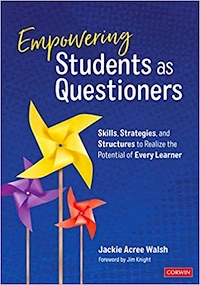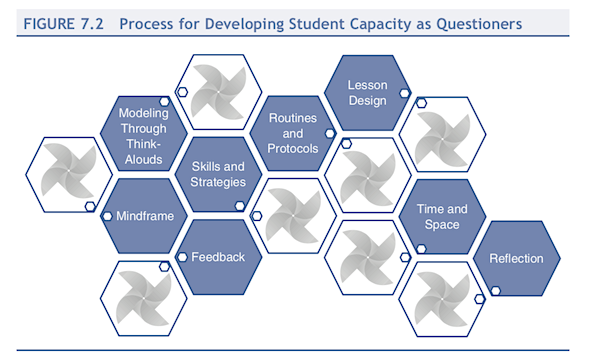How to Empower Students as Questioners
Empowering Students as Questioners: Skills, Strategies, and Structures to Realize the Potential of Every Learner
By Jackie Acree Walsh
(Corwin, 2021 – Learn more)
Reviewed by Kathleen Palmieri

Unfortunately, the majority of these questions are being asked by teachers, and they typically engage only a small percentage of students in the learning experience.

To further entice us, Walsh shares research about the learning gains students experience when they become effective questioners and also emphasizes the value teachers derive from the authentic feedback good questions provide.
Helping students see the value in asking good questions
Walsh believes that if we want to foster student self-efficacy in our classrooms, teaching them how to ask questions effectively is key. First and foremost, students need to realize that teachers ask questions to gauge student understanding and discover the best ways to support them as they learn.
This ‘realization step’ is essential. Once students see a rationale for sharing their thoughts and understand the the power that their questions can have in shaping instruction, they are ready to explore what Walsh calls questioning “mindframes.”
On page 28, Walsh highlights these Student Mindframes:
- Self-Questions (Metacognitive): I ask questions to myself to monitor my thinking and learning.
- Self-Questions (Cognitive): I ask questions to figure out the meaning of what I am reading or hearing and to think through problems and tasks.
- Academic Questions: I pose questions to clarify and deepen my understanding of academic content.
- Exploratory Questions: I use questions to channel my curiosity and to spark my creativity.
- Dialogic Questions: I ask questions to understand other perspectives and to engage in collaborative thinking and learning.
The four types of questions – self, academic, exploratory, and dialogic – along with their associated mindframes are each explored in a dedicated chapter. While she discusses each question type separately, Walsh also notes,
“…these question types are interrelated. They feed off of one another, a self question leading to an academic one, the academic one inspiring an exploratory one, the exploratory one resulting in dialogical exchanges…The question types are fluid and dynamic, not fragmented and mechanical.” (page 125).
The chapter on “Teachers as Activators” – the teacher’s own mindframe – focuses on setting explicit expectations and using the questioning process to build capacity. It includes informal inventories of student questions for multiple grade levels. Setting the plan for adopting routines and protocols, as well as incorporating these plans into daily lessons and offering time for process and reflection, are explored.
I found “The What, Why, and How of Think Times” (page 11) valuable in changing classroom practice from the traditional “wait time” to the more deliberate and impactful Think Time 1 and Think Time 2. Walsh recommends using hand signals or classroom signage to promote this strategy, but most importantly, to “teach students the specific kind of thinking they are to do during pauses” in the questioning process.
The book includes charts to use in class to help teach and use think time. “Teachers who commit to prioritizing the teaching of think time and supporting their students as partners in making this change (will) experience success,” writes Walsh (page 13).
Tips for transforming the classroom
This book is “envisioned as a manual of practice for teachers,” focusing on ways to actively transform classrooms and build a culture of students as questioners. This begins with the teacher’s commitment to transforming traditional classroom practices and helping students “develop the requisite knowledge and skills of effective questioners.”
Each chapter includes a “Spotlight” that offers online opportunities and concludes with “Curtain Call: Revisiting Key Ideas Related to…” the focus of the chapter. Figures and charts are offered throughout, helping to illustrate concepts and offer resources that can be easily incorporated into daily classroom lessons. Videos (QR codes) are inserted within each chapter to help provide a glimpse of the process being used in actual classrooms.
The big takeaway from this book is for teachers “to be activators” and to make the time to guide students in learning the art of self questioning. Daily interaction and adopting new routines that foster comfort and confidence in students to ask questions is key. “The intent of this book is to provide a manual of practice for teachers and students, a framework and resources to support advancement in using four types of questions.”

Building on her 30 years investigating the learning power of questioning, Jackie Acree Walsh has written a book that embraces the “skill, will, and thrill” that is woven throughout each chapter. She offers easily adopted ideas to effectively help empower students as questioners, embracing mindframes to ask questions that build on learning, and creating a classroom culture where teachers experience students learning by asking and answering their own questions.
Read a MiddleWeb article
by Jackie Walsh based on her new book.
Kathleen Palmieri is a National Board Certified Teacher and NBCT Professional Learning facilitator. She is a fifth grade educator in upstate New York who reviews and writes regularly for MiddleWeb. With a passion for literacy and learning in the classroom, she participates in various writing workshops, curriculum writing endeavors, and math presentations and loves to blog about ELA and math topics.
As a lifelong learner, Kathie is an avid reader and researcher of educational practices and techniques. Collaborating with colleagues and globally on Twitter @Kathie042500 and expanding her education adventures at www.kathleenpalmieri.com are ongoing practices.



































Excellent post! All students should be encouraged to ask questions of all taught. The right questions emerge and deeper learning results. Questioning IS engagement.